Pennsylvania Post-War With Modern Pilot #1361 -

Pennsylvania Post-War With Modern Pilot #3750 -

Pennsylvania Pre-War Brunswick Green #5440 (Gold & Red Stripes) -

Pennsylvania Pre-War With Slat Pilot #5448 -

Streamlined -

Pennsylvania Post-War With Modern Pilot #1361 -

Pennsylvania Post-War With Modern Pilot #3750 -

Pennsylvania Pre-War Brunswick Green #5440 (Gold & Red Stripes) -

Pennsylvania Pre-War With Slat Pilot #5448 -

Streamlined -

Introduced: 2015 (standard version) and 2022 (streamlined version)
As pictured above, these finely detailed and smooth running Pennsy steamers are available in four different permutations (all equipped with factory-installed DCC sound). And I have to say, major kudos to Bachmann for providing N scalers with yet another "road-specific" steam model. Now, where's my C&NW Class ES Pacific? Huh? Huh?
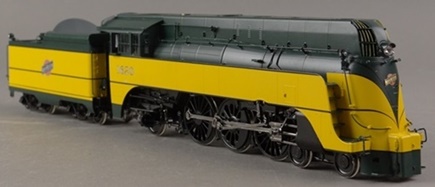
Sorry, don't mind me. I'm just feeling a bit jealous over here. Let's press on...
Internally, these models are similar in design to Bachmann's other steam locomotives of similar vintage -

The locomotive chassis is all-metal and split-frame. The boiler shell is metal as well (with separate press-fit plastic detail parts for the domes, etc). The flywheel-equipped motor (#10226) appears to be a new one for Bachmann. And although my suspicion is that it's coreless, it's also an enclosed can so there really isn't any way to verify that theory (not without tearing it apart anyway).
Four of the six drivers provide pickup (the center driver pair being equipped with traction tires). The pilot and trailing trucks are electrically neutral. All eight tender wheels provide pickup as well (by way of low-friction axle cups). Current is transferred from the tender trucks to the tender by way of sticky-uppy wipers that rub up against flexible contacts on the tender PC board. Current is transferred from the engine to the tender by way of a pair of stiff wires on the plastic drawbar. A PC board with a directional headlight is mounted to the front of the chassis. Wires for motor control and lighting control are soldered to the motor and lightboard (respectively) and run back to a socket connector that plugs into pins on the tender PC board. E-Z Mate automatic/magnetic couplers are mounted on the pilot and the tender chassis (Rapido-style couplers are also included in the box should you want to go that route). Wheels are low-profile, so no problems on Code-55 rails.


All drivers are equipped with separate bearing blocks. The rear two driver pairs are geared, whereas the forward driver pair is turned solely by the running gear. Apart from the brass worm, all gearing is white plastic (the same white plastic introduced on Bachmann's 2015 2-8-4, and presumably not the same crappy white plastic used by Bachmann back in the 80's and 90's).

A Soundtraxx DCC-Sound decoder comes plugged into a 9-pin connector on the tender PC board. Unfortunately, Bachmann did not provide any sort of dummy plug (or jumpers) that would allow one to remove the decoder and run the engine in straight DC mode. That said, it's not all that hard to homebrew it - just get a standard PC "option jumper" to join pin 2 (right truck pickup) to pin 3 (motor +) and another one to to join pin 7 (motor -) to pin 8 (left track pickup).
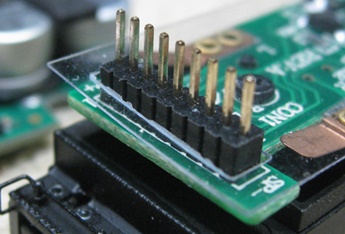
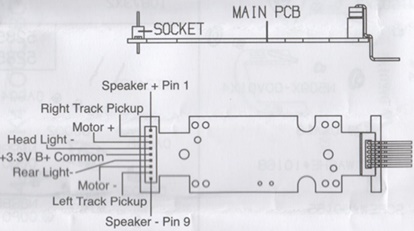
Note that the above modification will get you motor control, but not lighting control. Getting a working headlight is a bit more difficult, but if you're game, here's how to do it - first, jumper pins 2, 3 and 5 together. Next, jumper pins 7 and 8 together and wire them to a 1K ohm resistor. Lastly, wire the resistor to the pin 4 contact adjacent to the engine wiring harness (note that the pin contacts next to the wiring harness are numbered in reverse order from the decoder pins, so pin 4 would be the 4th from the bottom up, not the top down) -
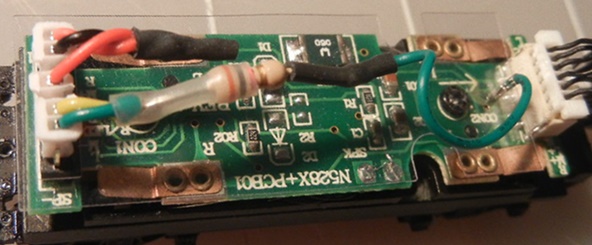
(Kudos to contributor Robert Bodie for providing the above photo and instructions)
These models do not come with tender backup lights (working or otherwise). I'm not sure why this particular detail was omitted (especially since Bachmann did go so far as to add the similarly sized/shaped marker light details). Based on the handful of pictures I've seen, the prototypical backup lights do have a bit of a kludgey "add-on" look to them, so maybe they were not present when the locomotives were originally built. But whatever the case, I guess that's something for the obsessive Pennsy fanatics to sort out.
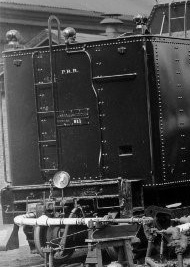
Note that the default behavior for the headlight is for it to be on all the time (just dimmed when the locomotive is moving backward). For more traditional behavior (IE, off when going backward and on when going forward) change CV 33 to 1. Also note that the default whistle setting is for a banshee-style air horn. For a more prototypical sounding three-chime horn, change CV 115 to 1 (said three-chime horn was not specifically recorded from a K4, but I'm told that it's at least pretty close).
Overall performance on these models is quite excellent (in both DCC and DC modes). Pickup and current conductivity are exceptional, making for very smooth throttle response. The moving parts synch up nicely, making for extremely quiet running (when the sound is turned off, that is). Pulling power is very impressive, with mine comfortably able to haul 20+ MTL heavyweight passenger cars through curves on level track (no doubt outperforming the prototype by a wide margin in that regard). I didn't have any problems with any of the wheels derailing (even on curves as sharp as 9.75"-radius). Well, not any major problems anyway (see below). The DCC Sound feature seems adequate enough (although as frequent visitors to this site may have noticed, I'm not a huge fan of DCC-Sound in N scale, so my opinions in that regard are pretty irrelevant).
The only minor quibble I have with mine is that the starting speed (at speed step 1) isn't quite as low as I've seen with other locomotives (although pretty typical for Bachmann steam locomotives of similar vintage). Don't get me wrong, it's plenty slow. It's just not capable of the "slower than the eye can detect" type speeds that one can get with, say, a Kato steamer. In a similar vein, the mechanism seems to run just a tad uneven at said slow speeds. No, not anything you'd ever really notice when operating the locomotive, but if you're just sitting there eyeballing it up close (and are extremely anal-retentive), the slight hitches in its get-along are certainly evident. But of course, this is all at speed step 1. Once you get out of the yard and get going, performance is just as smooth as can be. The only other speed issue I noted is that the top-end speed is quite high (at least as compared to Bachmann's other recent steamers). But being a passenger train engine, perhaps this was on purpose.
One potential area of concern relates to the trailing truck on the engine - specifically, the low-hanging spring details on the truck sideframes. These things hang down really low, and at least one person informs me that they can snag the frogs on Peco Code-55 turnouts and crossovers. As for me, I did notice that when breaking mine in in reverse (running around in circles for hours and hours), the trailing truck did derail a couple of times on my Kato Unitrack crossovers. If this turns out to be a major problem on your layout, the suggested solution would be to simply Dremel the spring details a bit shorter in order to provide some extra breathing room.
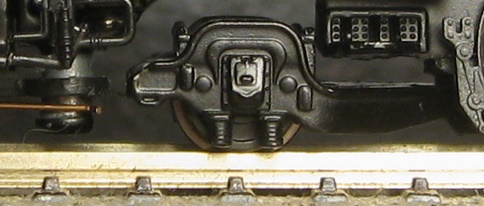
Finally, some have registered consternation over the fact that these models are not labeled as being part of Bachmann's "Spectrum" line. However, I'm not sure that that really means anything anymore. From what I've seen, current locomotive packaging is all "gold label" and simply denotes models as being DCC-Sound equipped, DCC-Equipped, or none of the above (IE, no support for DCC at all). So, the old "Spectrum" label may simply have been retired by Bachmann.
Features -
- DCC-equipped for speed, direction and lighting
- Includes Sound Value SoundTraxx Steam Package
- Prototypical chuff, short and long whistles, bell, air pump, steam release and blower
- Precision motor w/brass flywheel, die-cast chassis
- Directional LED headlight
- "Chicken coop" slat pilots on the Pre-WWI models, modern pilots on the Post-War versions
- Metal wheels
- Prototypical details
- Magnetically operated E-Z Mate Mark II couplers
- MSRP $399.00
Trivia - Keystone Details makes a conversion kit to turn a standard Bachmann K4 into a streamlined K4 -
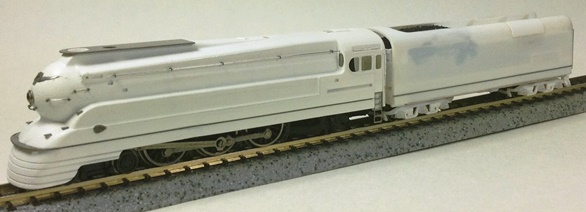
Shell Removal -
To remove the locomotive shell, unscrew the two screws behind the trailing truck and free the pilot handrails from the boiler shell. Next, raise the cab end of the shell up until it clears the chassis and then slide the shell forward a bit to clear the headlight LED. The shell should lift right off at that point. To remove the tender shell, unscrew the two screws behind the forward truck. Next, lift up the front end of the shell and then wiggle loose the two plastic clips on the back end of the shell. The shell should then pop off.
Grade: A